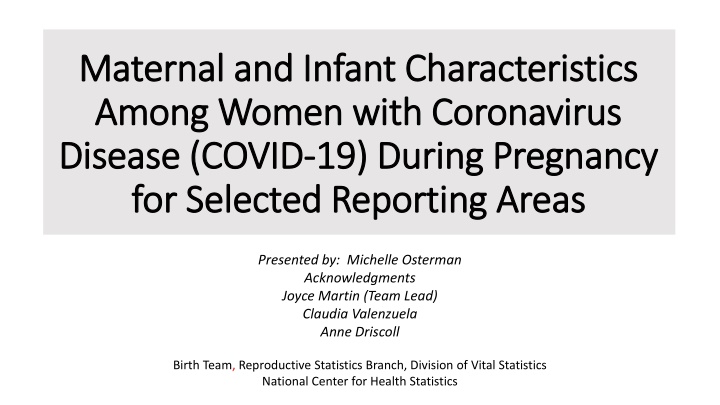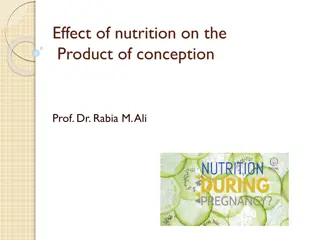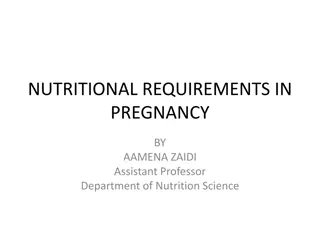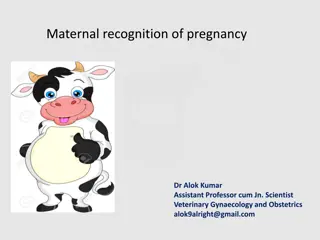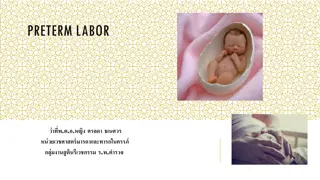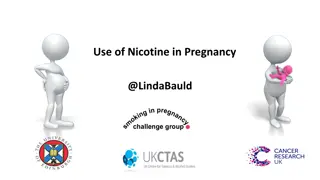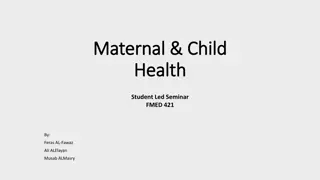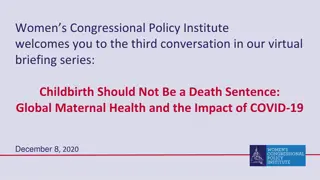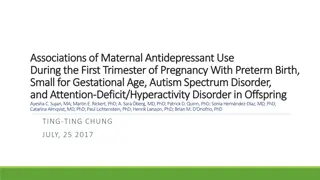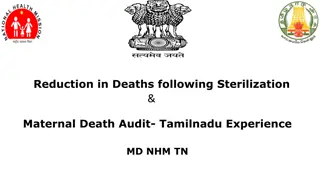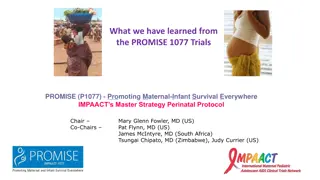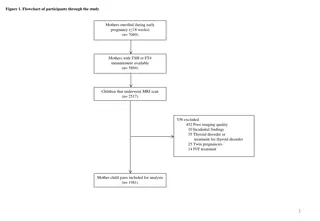Maternal and Infant Characteristics During COVID-19 Pregnancy
This study focuses on assessing the impact of COVID-19 on pregnancy, childbirth, and newborns. It delves into the history, data collection methods, and recommended questions related to maternal COVID-19 status. The urgency of the pandemic prompted the development of alternative approaches to collect essential data for ongoing evaluation.
Download Presentation

Please find below an Image/Link to download the presentation.
The content on the website is provided AS IS for your information and personal use only. It may not be sold, licensed, or shared on other websites without obtaining consent from the author.If you encounter any issues during the download, it is possible that the publisher has removed the file from their server.
You are allowed to download the files provided on this website for personal or commercial use, subject to the condition that they are used lawfully. All files are the property of their respective owners.
The content on the website is provided AS IS for your information and personal use only. It may not be sold, licensed, or shared on other websites without obtaining consent from the author.
E N D
Presentation Transcript
Maternal and Infant Characteristics Maternal and Infant Characteristics Among Women with Coronavirus Among Women with Coronavirus Disease (COVID Disease (COVID- -19) During Pregnancy 19) During Pregnancy for Selected Reporting Areas for Selected Reporting Areas Presented by: Michelle Osterman Acknowledgments Joyce Martin (Team Lead) Claudia Valenzuela Anne Driscoll Birth Team, Reproductive Statistics Branch, Division of Vital Statistics National Center for Health Statistics
Outline History/purpose Methods Results
History/Purpose Question What impact does having COVID-19 during pregnancy have on the mother and newborn? Goal Assess impact of COVID-19 on pregnancy, childbirth, and newborns on an ongoing basis
History/Purpose (cont.) In March 2020, RSB Natality team began efforts to encourage states to collect maternal COVID-19 status Urgency of pandemic did not allow for new data items to be added to the U.S. Standard Certificate of Live Birth Alternative approach needed to collect COVID-19 data Worked through the national Birth Data Quality Workgroup to Develop recommended question(s) Develop alternative approaches Encourage collection Develop standards and processes for reporting
Data Collection Some jurisdictions had the flexibility to modify electronic birth certificate reporting systems and add a maternal COVID-19 item Others were able to link COVID-19 status information from infectious disease surveillance systems to birth certificates or to collect data through use of supplementary forms All jurisdictions report maternal COVID-19 at any time during pregnancy
Recommended question options INFECTIONS PRESENT AND/OR TREATED DURING THIS PREGNANY (Check all that apply) Did the mother have confirmed or presumed COVID- 19 (SARS-CoV-2) at any time during this pregnancy? Gonorrhea Syphilis Chlamydia Hepatitis B Hepatitis C COVID-19 (confirmed or presumed) None of the above Yes No
Recommended question options (cont.) INFECTIONS PRESENT AND/OR TREATED DURING THIS PREGNANY (Check all that apply) Did the mother have confirmed or presumed COVID- 19 (SARS-CoV-2) at any time during this pregnancy? Gonorrhea Syphilis Chlamydia Hepatitis B Hepatitis C COVID-19 (confirmed or presumed) None of the above Yes No If yes, specify the period(s) during which a confirmed or presumed diagnosis of COVID-19 was present: First trimester Second trimester Third trimester At delivery Time of infection unknown
Methods 15 jurisdictions are currently providing data Variable reporting period; reporting start dates vary by state, ranging from March through mid-June Data for all 15 jurisdictions from June 19, 2020 February 2021 Jurisdictions differ in how information on COVID-19 status was obtained Some states report both presumed and confirmed maternal COVID-19; others report confirmed cases only Reported cases of COVID-19 are linked to the standard birth record at NCHS using provisional 2020 and 2021 data
Reporting jurisdictions Alabama Alaska Arkansas California District of Columbia Idaho Maine Maryland New Hampshire North Dakota Ohio Oklahoma Oregon Tennessee West Virginia
Birth COVID-19 Webpage Results published on webpage on a bi-monthly basis Comparisons made for COVID-19 vs. no COVID- 19 by race and Hispanic origin Maternal characteristics/outcomes Age Education Medicaid as source of payment for the delivery ICU admission Infant outcomes Preterm birth Low birthweight NICU admission Infant living
Birth COVID-19 Release Webpage https://www.cdc.gov/nchs/covid19/technical-linkage.htm Data published: April through October January 2021 April through December March 2021 April through February May 2021
Results Results Maternal COVID-19 reporting area compared with all US births 27% of all U.S. births during the reporting period Smaller proportion of births to non-Hispanic white, non-Hispanic black women Larger proportion of births to Hispanic women Lower preterm birth rate United States COVID-19 reporting area Births to non-Hispanic white women 51.6% 50.3% Births to non-Hispanic black women 14.7% 13.2% Births to Hispanic women 24.3% 25.3% Preterm birth rate 10.03% 9.83%
Results (cont.) Results (cont.) 99.6% of all cases linked with full birth record More than 23,000 births to moms with presumed or confirmed COVID-19 Approximately 750,000 births to moms without COVID-19
Results - Distributions 14 state and DC Maternal COVID-19 reporting area
Distribution of births by race and Hispanic origin and Distribution of births by race and Hispanic origin and COVID COVID- -19 status: April 2020 19 status: April 2020- -February 2021 February 2021 100% Non-Hispanic other 90% Non-Hispanic black 80% 70% 60% Non-Hispanic white 50% 40% 30% Hispanic 20% 10% 0% COVID-19 Yes COVID-19 No NOTES: COVID-19-Yes includes presumed or confirmed cases. Non-Hispanic other includes: non-Hispanic Asian, non-Hispanic American Indian or Alaska Native, non-Hispanic Native Hawaiian or Pacific Islander, and non-Hispanic multiple race.
Distribution of births by maternal age and COVID Distribution of births by maternal age and COVID- -19 status: April 2020 status: April 2020- -February 2021 February 2021 19 100% 40 years or more 90% 80% 30-39 years 70% 60% 50% 40% 20-29 years 30% 20% 10% Under 20 years 0% COVID-19 Yes COVID-19 No NOTE: COVID-19 Yes includes presumed or confirmed cases.
Distribution of births by maternal education and COVID Distribution of births by maternal education and COVID- - 19 status: April 2020 19 status: April 2020- -February 2021 February 2021 100% 90% Bachelor s degree or higher 80% Associate degree 70% Some college 60% 50% 40% High School graduate or GED 30% 20% Less than High School 10% 0% COVID-19 Yes COVID-19 No NOTE: COVID-19 Yes includes presumed or confirmed cases. Includes women who may not have had time to complete their education.
Results - Outcomes 14 state and DC maternal COVID-19 reporting area
Maternal ICU admission by COVID Maternal ICU admission by COVID- -19 status and race and Hispanic origin: April 2020 Hispanic origin: April 2020- -February 2021 19 status and race and February 2021 COVID-19 Yes COVID-19 No 1.2 1.0 0.8 Percent 0.6 0.4 0.2 0.0 All races and origins Non-Hispanic white Non-Hispanic black Hispanic Race and Hispanic origin NOTE: COVID-19 Yes includes presumed or confirmed cases.
Preterm birth by COVID Preterm birth by COVID- -19 status and race and Hispanic 19 status and race and Hispanic origin: April 2020 origin: April 2020- -February 2021 February 2021 All race and origins Non-Hispanic white Non-Hispanic black Hispanic 18 16 14 12 Percent 10 8 Late preterm (34 to 36 weeks) 6 4 2 Early preterm (Less than 34 weeks) 0 COVID-19 Yes COVID-19 No COVID-19 Yes COVID-19 No COVID-19 Yes COVID-19 No COVID-19 Yes COVID-19 No NOTE: COVID-19 Yes includes presumed or confirmed cases. Gestational age based on obstetric estimate.
NICU admission by COVID NICU admission by COVID- -19 status and race and Hispanic origin: April 2020 Hispanic origin: April 2020- -February 2021 19 status and race and February 2021 Covid-19 Yes Covid-19 No 16 14 12 10 Percent 8 6 4 2 0 All races and origins Non-Hispanic white Non-Hispanic black Hispanic Race and Hispanic origin NOTE: COVID-19 Yes includes presumed or confirmed cases.
Limitations Not national data; not representative of entire U.S.; CA births over-represented No information on when in pregnancy the mother had COVID-19 Some reporting areas did not report COVID-19 status for entire reporting period For example, California began reporting on June 10; Oklahoma on June 19. Different methods of reporting COVID-19 status Surveillance vs. birth certificate Confirmed only vs. presumed/confirmed However, more complete national data do not currently exist
Next Steps Continue to update the webpage release bi-monthly Add more reporting areas Perform more detailed analysis
